For classic car enthusiasts, there are many variations of the First Generation Mustang that are instantly recognizable. Badges like Mach 1, Boss, or GT spring to mind, but one that might seem more foreign is the “T-5.” The word foreign is an appropriate term because it was a variant that Ford built for export to Germany. How the car received the designation is a story within itself, but the production total was one of the lowest in the Mustang’s history. Our feature car has undertaken some travel in its life, but it has returned home and is searching for a new owner to restore it to its former glory. If you fancy becoming the next owner of a car with an interesting past, you will find the Mach 1 located in Assonet, Massachusetts, and listed for sale here on eBay. Bidding has rocketed past the reserve and currently sits at $15,600.
The story behind the T-5 is one of trademark issues and deserves a brief background. Ford was one of several manufacturers that exported cars to military personnel serving overseas via the Military PX system. Most of these cars found their way to European destinations, but it was those that Ford exported to Germany that proved to be a fly in the ointment. The company was happy to sell the Mustang in that country, but a company called HDK owned the trademark rights to the Mustang name. They were a manufacturer of large trucks but did not want that badge attached to a passenger car. They offered Ford the option of purchasing the trademark name for $10,000, but Ford felt that it was an unjustifiable expense with the sales volumes involved. As things eventuated, the trademark expired in 1979, so Ford was free to use the name after that date. As an interim measure, Ford removed all Mustang identification from their models, renamed them the T-5, and sold them to military personnel. When you examine our feature car carefully, the only Mustang reference that you will find is the solitary badge in the grille center. Beyond that and the Mach 1 decals, you will find nothing. The supplied Marti Report figure gels with other sources that indicate that Ford exported a total of 261 Mustangs during the model year. However, I have found additional information that suggests that a mere two of those cars were Mach 1s. Verifying this figure conclusively may require some intense detective work, but if it can be confirmed, that makes this one of the rarest Mustangs in existence today. Our feature car rolled off the production line wearing Grabber Green Metallic paint. In 1985, the owner (the seller’s grandfather) performed a color change to its current shade of white. The paint looks tired today, but apart from that, a dent in the driver’s side front fender and one in the roof from a bullet ricochet (!), that seem to be the extent of the bad news. Fixing the fender and roof should be easy, but the buyer won’t have any rust to tackle. The seller says that all of the usually prone areas are sound, and the supplied photos indicate that this car may have been undercoated early in life. The floors and frame rails are spotless, as are the torque boxes. There may be some trim that requires attention, but overall, this looks like it could be a straightforward restoration.
Lifting the T-5’s hood reveals a 351-4V Cleveland V8 that would’ve produced 285hp in its prime. The original owner rounded out the package by choosing the wide-ratio four-speed manual transmission, a 3.25 Traction-Lok rear end, power front disc brakes, competition suspension, and a Ram Air setup. Pointed at a ¼ mile, it should have completed the journey in 14.9 seconds. It appears that when the vehicle returned from Germany via Baton Rouge in 1981. It remained in active use for the next fifteen years before the owner placed it into storage. The seller recently awoke the Mach 1 from hibernation by replacing all of the fluids, flushing the fuel system, and rebuilding the carburetor. It seems that the car runs and drives, but it isn’t clear whether it is roadworthy. If it isn’t, returning it to that point should be a satisfying task for the buyer to tackle. It is worth noting that the Magnum 500 wheels aren’t original, and their condition suggests that these and the tires may have been a recent addition by the seller.
This Mach 1’s interior is a bit of a surprise because it is in better condition than I expected. It needs a new dash pad and front seatcovers, but the remaining upholstered surfaces look pretty respectable. I can’t spot any issues with the headliner, and none of the plastic appears to be crumbling. Overall, the interior looks like it has been treated with respect, so whipping it into shape shouldn’t cost the buyer more than $600 for a pad and seat upholstery. It appears that there have been no aftermarket additions, so the car retains its sports instrument cluster and AM/FM stereo radio.
When I look at this 1971 Mach 1, I see a surprisingly solid, original, and complete vehicle that should represent a straightforward restoration project. Once the buyer has completed the work, they will be left with a classic that could turn heads. Its relative rarity and history make it interesting, but it is hard to determine whether it adds to its potential value. Even if it doesn’t, the lack of Mustang badges and its back story should make a great conversation starter at a show or a Cars & Coffee. The bidding has already been spirited, so this auction might be worth watching.
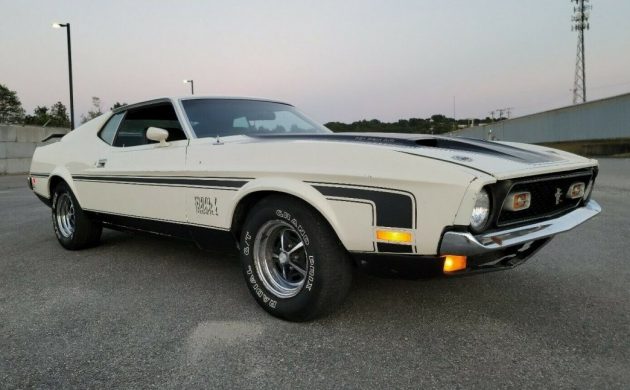
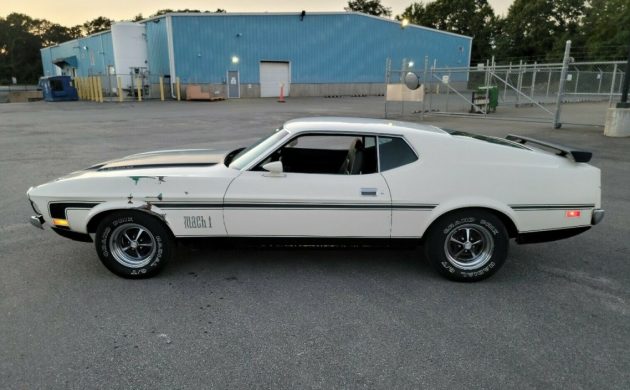
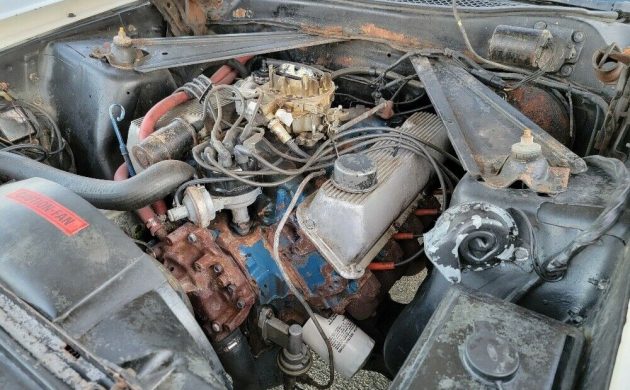
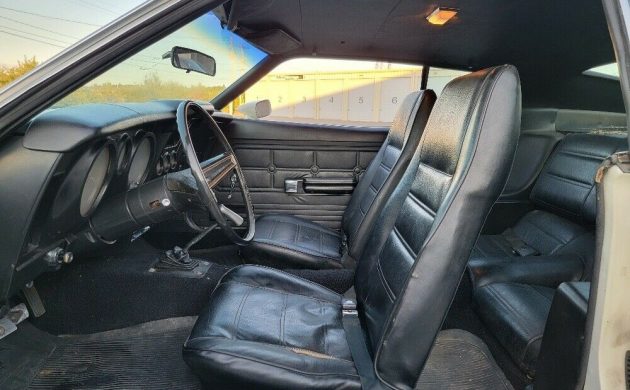
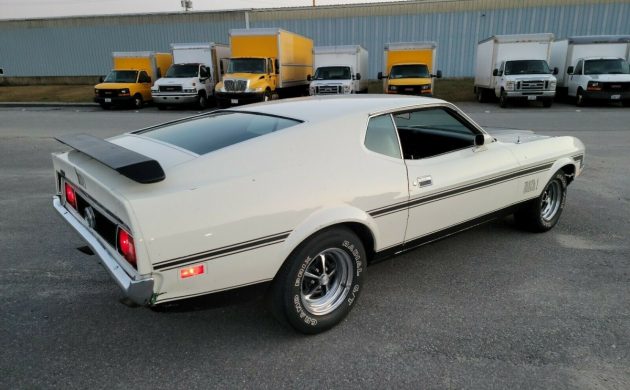


Great post and very good write-up! Super rare car as mentioned, this is one of only about 2 or 3 ‘71-‘73 Mustang T-5’s I’ve seen since my Mustang obsession started nearly 40 years ago. One big correction to the info is that, to my knowledge, this car is NOT a factory Mach 1, but rather a really nicely optioned Fastback. The Marti Report clearly shows “63D” on the body code vs “63R” – the body code for the Mach 1. Interestingly, the Boss 351 cars also carried the 63D body code for the (usually) more plain Fastback models. I’d guess the Mach 1 stripes were probably a “self-upgrade” back when the car was repainted? This shouldn’t take away from the huge cool factor of the car, just an important difference for the next Owner to consider. I think it would pay well to have this car returned to its “as born” color, condition. Awesome vehicle!
I believe there were a couple that were Mach1’s T5s out there…
Also interesting that this car doesn’t say “T5” anywhere on it. I thought the one I saw once said T5 on the fender and possibly on the dash. I thought there is a fender tag as well. Nice to see a Marti but would think the seller would include some pics of these T5 details. A pic of the speedometer in Kilometers at minimum
My 2011 GT was originally delivered to a service member in Switzerland. It doesn’t say “Mustang” on it anywhere, but these days, none of them do.
Hello friends !
What a great interesting story about this T-5 Export Mustang ! I had never heard of one and it’s superb that it has survived. I too own a German export , a 1972 Charger Rallye, ordered by a young Army soldier in February of 1972 who was stationed in Germany and ordered his Charger from the PX. When I found the Charger Rallye in 2014, it was in very sad shape, it has taken me till this year to really enjoy the car. After alot of cleaning and replacing of worn parts, it drives and runs wonderfully. It was ordered with the base 318 & 904 transmission but mechanically, it’s a great car. I’ve caught the grief from the Mopar community about how it is not a true “musclecar” and that I should drop in a big block….no, not going to happen with this car. I added a Edelbrock carb & intake, 2-1/2″ exhaust with Flowmaster 40 Series mufflers and runs great and sounds like a much bigger motor. People were surprised when I open the hood to reveal a economical 318. It’s just a driver with a unique history. As I continue to “restore” it cosmetically, I will enjoy the thumbs up and favorable comments. Stay safe and be well friends !!
Here is the export tag on my 1972 Dodge Charger Rallye. I bought the car from the original owner.
I put on a spare 1971 Charger R/T grill I had on my 1972 Charger Rallye because the original grill crumbled in my hands when I attempted to remove it for cleaning. I also added the 1971 R/T stripes, 15″ Rallye wheels, front & rear spoilers, and converted it to a console shift selector instead of column selector , new suspension and brakes. Thank you.
I’m not buying the T5 story on this car. All the T5’s I have seen, had the call out on the front fenders. It appears this car was a Mustang built for the U.S. market, then shipped to a service member in Germany. The Marti report should reflect a T5 designation, for a car built for the German market. As I remember, Mustangs sold in the U.S. and shipped to U.S. service members in Germany did not have to be designated T5’s, since they were not sold on the German economy. However, my memory is not what it was in the early 70’s.
That’s more in line with the story I’d heard, T-5s were sold alongside Taunuses and Escorts to the German public through Ford-Werke’s regular dealer network, neither cars sold to American servicemembers through the Exchange system nor any brought in by gray-market importers were rebadged.
John L,
You are correct. I know because I was living in central Germany as a US Army soldier back then. As a gearhead, I often made a bee-line to the big PX at Ben Franklin Village where they had the US cars for sale. None of the Mustangs I saw there had the T-5 designation, they had regular Mustang emblems.
Here is the reason why: Any service member wishing to buy a car thru the PX system had to agree to sell it to another US serviceman or US citizen working for the military, OR ship it to their next duty station.
It was difficult to sell it to any European, because all the European vehicle registration offices knew that anyone buying the car then had to pay the original import taxes when new [Not the value of a used car, but the tax on the car when new].
Actual Ford T-5 cars had the aforementioned T-5 emblem on the left front fender. Because all speedometers by 1971 were both MPH and KPH, the Speedometers for European export were the same.
Unless the owner kept the T-5 emblem, and the back side of the left front fender has evidence the fender was drilled for the T-5 emblem, I’m of the belief this is NOT a T-5 Mach 1.